In the 2021 State of Product Management Report, our annual collection of data designed to bring to life the trends driving product management, we found gender diversity, or lack thereof, a prime opportunity for product management teams to create more intentional inclusivity.
Let’s further understand where things currently stand with gender diversity in the product management space. Additionally, we’ll explore ways to move the needle toward greater inclusivity and, ultimately, better business outcomes.
Where are the Women in Product?
Today’s data indicates we have plenty of room for improvement if our sights are set on greater inclusivity. In the tech industry, men outnumber women, and in technical roles especially. In product management, men outnumber women almost 2:1.
Two key findings stood out to us in our 2021 report: men hold 65% of senior roles and, on average, earn 7% more than women in product management.
Let’s walk through the report’s data to understand better what the current product management landscape looks like in terms of gender inequality.
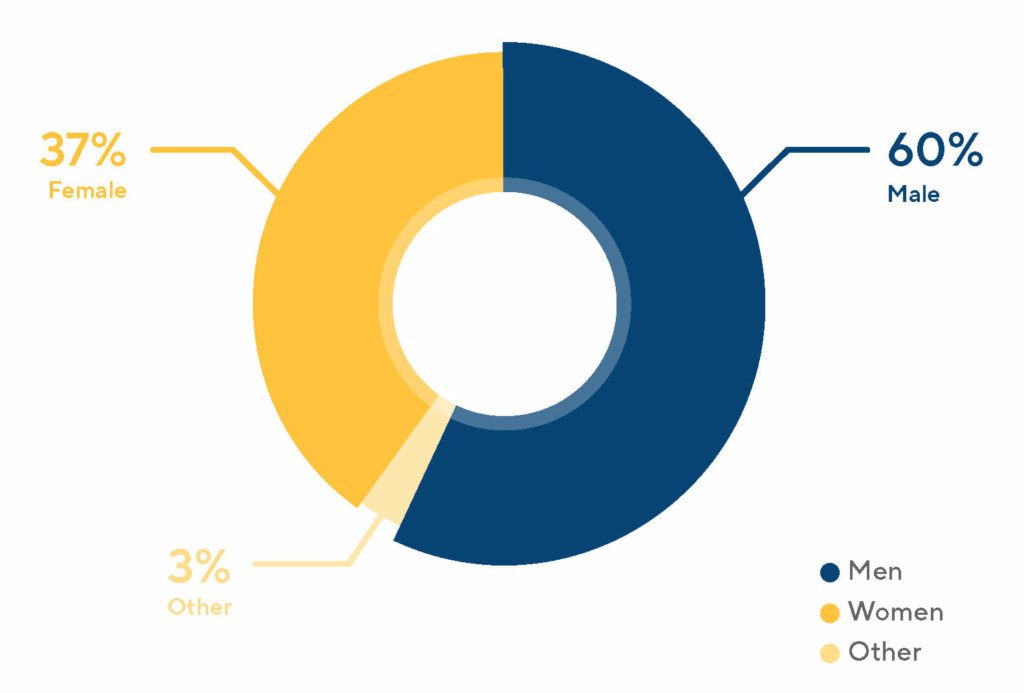
Currently, the product management space is predominantly held by 60% men, 37% women, along with 3% that either prefers not to disclose or identify as non-binary.
This isn’t what the numbers showed just two decades ago when greater gender diversity in product management. Deborah Liu, VP of Product at Facebook, explains:
“In the early to mid-2000s, Product Management at tech companies had almost the same number of men and women. So they came up with the solution to filter down to technical PMs, [with] the requirement that they have a degree in computer science—or a related field like electrical engineering. Unfortunately, in 2005, women only earned about one in five CS degrees in the US, which continues today. I believe that the new technical requirement changed the pool of potential PMs to one which was heavily male-dominated and thus unintentionally led to the industry moving away from gender-balanced teams.”
Women in Senior Management
The impact of the years with fewer women in product, plus the higher churn of women in this role, is finding its way into senior leadership. Just 36% of senior product roles are held by women, compared to 64% held by men.
To compound matters further, churn in tech is much higher for women. According to a Harvard Business School study, 41% of women leave a decade after starting in tech, compared to 17% of men.
Of course, the global pandemic didn’t do women in the workforce any favors. On the contrary, it “set women’s labor force participation back more than 30 years.” As a result, nearly 3 million women dropped out of the workforce in 2020.
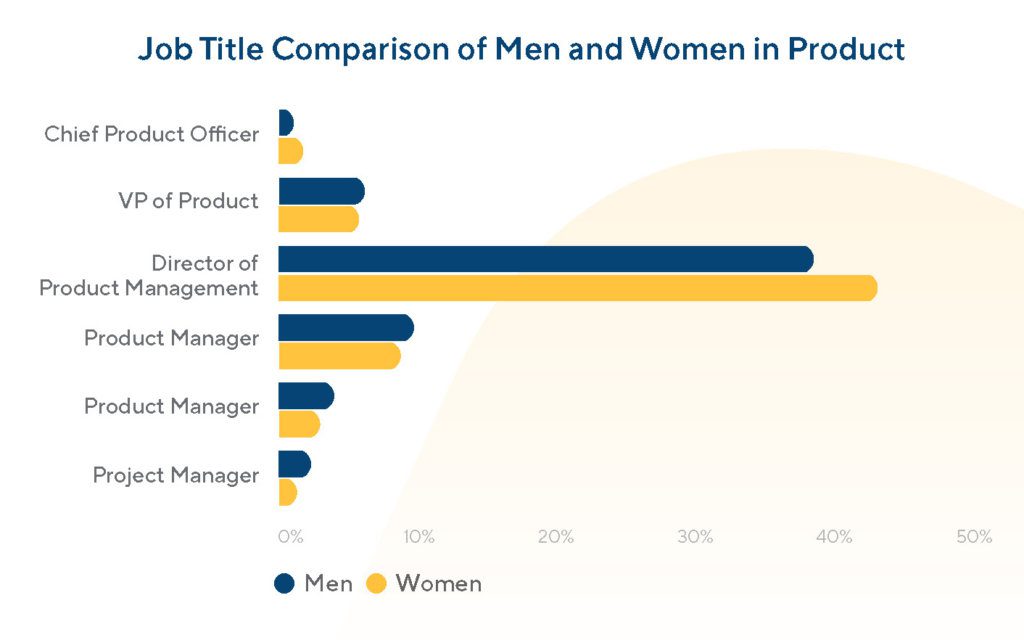
On the subject of gender inequality in senior management, Martin Eriksson, co-founder, and chairman of Mind the Product, writes:
“A University of Maryland study looking at 15 years of data from the S&P1500 found that female representation in senior management brought informational and social diversity benefits, enriched the behaviors exhibited by managers throughout the firm, and motivated women in middle management. All of which resulted in improved individual and company performance – especially where the firm’s strategy was focused on innovation, in which context the informational and social benefits of gender diversity and the behaviors of more diverse teams had a bigger impact.”
Salary Earnings for Women in Product
Inclusion and innovation may go hand in hand, but women are still earning less than their male counterparts in nearly all occupations.
According to the Bureau of Labor Statistics, women’s annual earnings were 82.3% of men’s earnings in 2020. The salary gap is even wider for women of color.
Salary discrepancies between men and women tend to vary by the number of years of experience. However, overall, men make 7% more than women in product management. While there is certainly work to do, women in product management (and technology in general) have made strides in recent years to reduce this gap.
That being said, men, on average, earn a higher salary (based on years of experience) at every level than their female counterparts.
- 7% more for 0-2 years
- 2% more 3-5 years.
- 3% more 6-10 years
- 9% less 11-15
- less than 1% more than 15 years
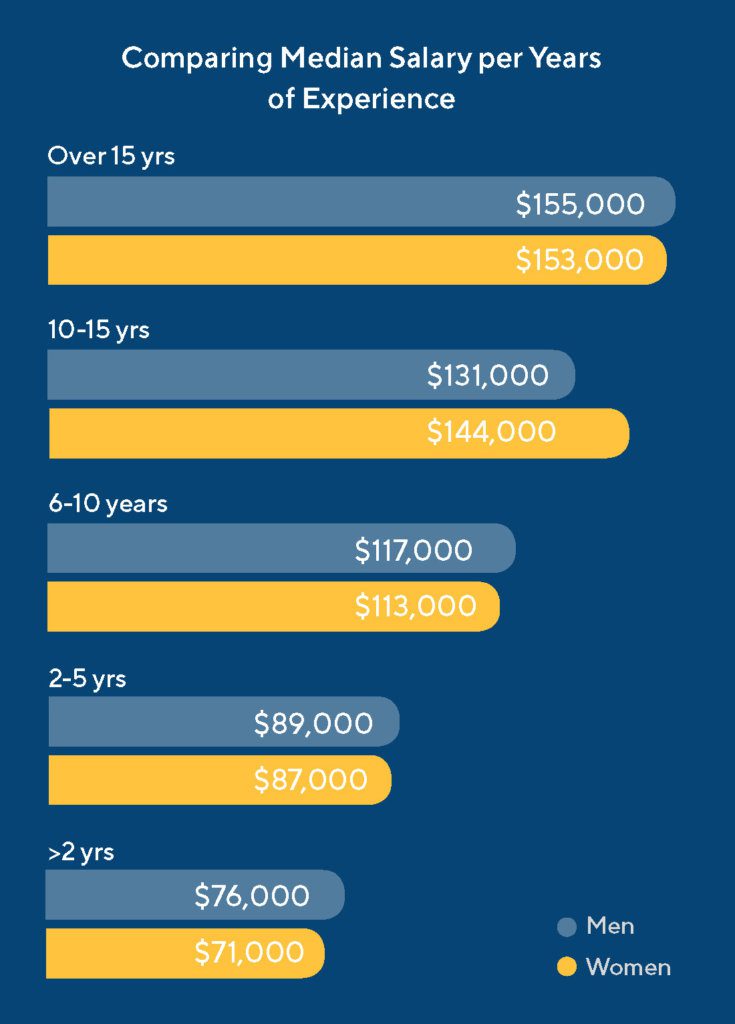

Not surprisingly, advanced degrees play a role in commanding a higher salary. In addition, data shows that men in product tend to have more advanced degrees than women.
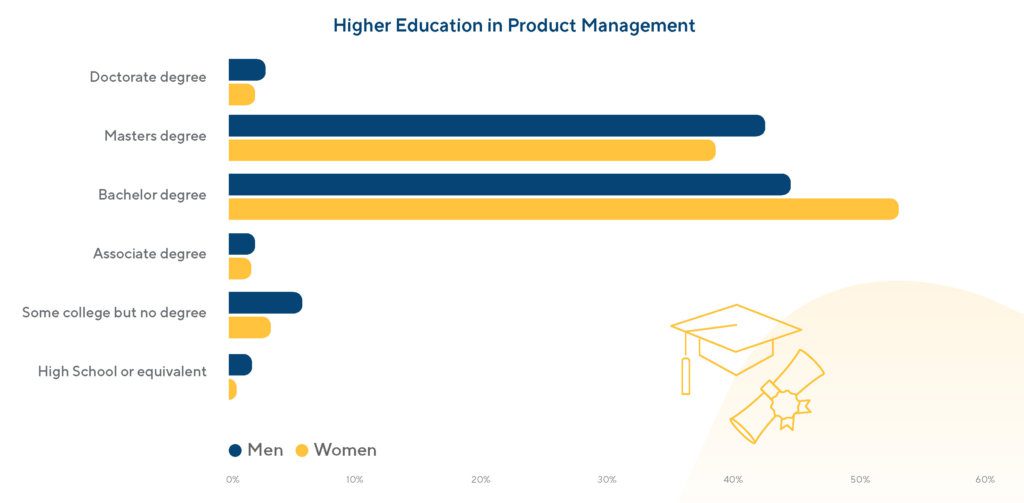
Imposter Syndrome and Career Goals
Our report also found that women in product are 14% more likely to frequently or consistently feel imposter syndrome in their careers than men. For the lucky few that only rarely or never feel it, 19% were women, and 26% were men. Additionally, women are more likely to feel neutral or unhappy about their work compared to men.
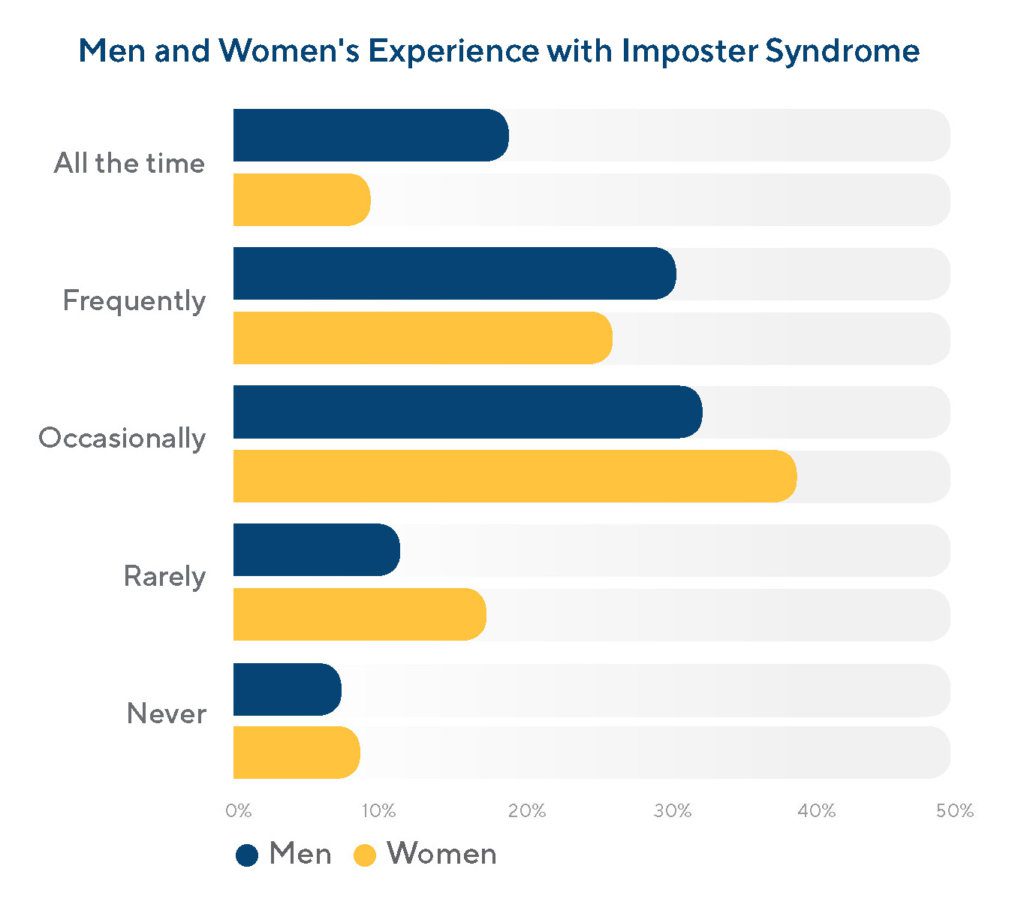
Nearly half of product people say their 10-year career goals are to become a product leader. According to our report, both women and men see product leadership in their future. However, many women are looking at product leadership for more years of their careers. After a while, mens’ goals shift toward starting their own company—the second most voted category.
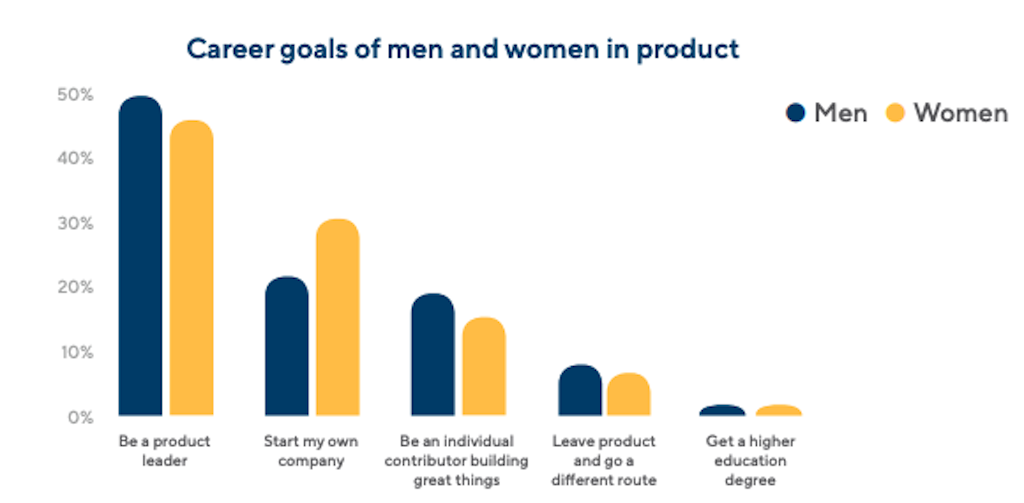
That’s a current snapshot of the state of gender inequality in product management. So how do we move the needle towards greater inclusivity?
Read what women bring to product management.
Inclusivity is the Future
The need for greater inclusion was never more top-of-mind for many product teams than in 2020.
Studies show that gender diversity in teams produces better results. Inclusion helps us perform better. Groups of diverse problem solvers outperform groups that share everyday experiences, backgrounds, and identities.
Put, more voices, experience, and perspectives in product development translate to better products out in the world. Therefore, prioritizing inclusivity is the way forward.
In “Why Diversity Isn’t Just Right, but Smart,” Eriksson asserts:
“A good product team needs a mix of design, tech, and business, a mix of genders and backgrounds, a mix of industry experience and product management experience, and a mix of skills from the visionary to the detail-oriented, from the data-hungry to the user research fanatics. This level of diversity is not just the best chance you have of representing your audience, but also ensures you’re always bringing the best experience to bear on any product challenge you face.”
Benefits of Gender Diversity Across the Organization
Gender diversity is linked to greater profitability and better customer experiences. It also helps companies attract and retain talented people.
Mina Radhakrishnan, the co-founder of Different and 1st Head of Product at Uber, believes that:
“The more identities, backgrounds, and experiences represented by founders and product managers, the more problems solved, the more user perspectives understood, and the more products launched by teams who have a handle on how the world will receive them.”
According to the Diversity Council of Australia, people who work in inclusive teams are:
- 10x more likely to be highly effective
- 9x more likely to innovate
- 5x more likely to provide excellent customer service
- 19x more likely to be very satisfied in their jobs
- 4x more likely to remain with their current companies
- 2x more likely to receive regular career development opportunities
Yet despite these compelling correlations between gender diversity and better business outcomes, gender representation only increased by 2% between 2015 and 2018.
Want to improve your sphere of inclusivity? Here are some of the women in product management you should be following.
Groups Driving Inclusive Policies and Practices
Several groups are actively discussing advocating for equal representation in product management.
The nonprofit Women In Product, founded in 2016, has a mission to “equip women to thrive in product management careers at all levels.” Created to connect women in the product field while also advocating for a more diverse workplace, it has 27 chapters worldwide, more than 33,000 community members. It hosts 125+ annual events to increase access to resources for skill development and offer exposure to opportunities with allied organizations that are “driving innovation through inclusive policies and practices that encourage mobility for women in product.” The organization’s vision is to ensure that “all people in product have equitable opportunities to build rewarding careers and shape the products of the future.”
Similarly, the Advancing Women In Product (AWIP) organization is dedicated to providing members with “the right skill sets and executive mentorship” that women need to accelerate careers in product management. It also has chapters around the world.
Get inspired by these six fantastic product managers who also happen to be women.
Going Beyond Gender Diversity
We have to be careful not to view gender diversity as just another box to check. In the quest to achieve greater inclusivity, this can potentially become a pitfall.
In “Diversity in Product Management Needs to Go Beyond a Gender Agenda,” Amanda Ralph, co-founder of Product Women, urges product teams also to seek cognitive diversity:
“Good product managers know what many in social sciences are now evidencing – that effective teams not only have diverse backgrounds and experiences but importantly, are cognitively diverse and inclusive. Actively including and seeking diverse perspectives and thinking (cognitive diversity) leads to better outcomes.”
Ralph adds, “We must have a culture which is not only inclusive but which also actively mobilizes and leverages the different perspectives that diversity invariably brings.”
Striving for cognitive diversity in the workplace might sound like an overwhelming challenge. Thankfully, organizations like Inclusion Ventures help teams and companies develop strategies for decreasing bias and enhancing inclusion.
Learn how to recognize and reduce cognitive bias as a product manager.
Moving the needle towards greater inclusivity is a marathon. To make meaningful strides towards gender diversity, we first have to reckon with where things stand today.
The goal of any product team should be to build great products. Inclusivity can help shape this outcome. It attracts more voices, experience, and perspectives to your product team. And ultimately, the products you build and release into the world will be better for it.





